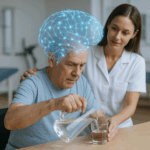
Ignite Your Workout: The Crucial Prelude To Always Warming Up
Exercise is an integral part of a healthy lifestyle, offering a myriad of benefits for both the body and mind. Whether you’re an avid gym-goer, a recreational athlete, or someone just starting their fitness journey, one universal truth remains — warming up before exercise is not just a suggestion; it’s a necessity. In this blog post, we’ll delve into the importance of warming up, exploring the physiological and psychological benefits, the different components of an effective warm-up routine, and tips on how to make the most of this crucial prelude to physical activity.
THE PHYSIOLOGY OF WARMING UP
To understand the significance of warming up, it’s essential to grasp the physiological changes that occur in the body during this preparatory phase. When you engage in physical activity, your body transitions from a state of rest to one of increased demand for energy and oxygen. Warming up gradually raises your heart rate, increases blood flow to the muscles, and enhances joint flexibility. These changes optimize your body’s ability to meet the demands of exercise and reduce the risk of injury.
- Increased Blood Flow
A proper warm-up initiates a gradual increase in heart rate and blood flow throughout the body. This process serves several purposes, such as delivering oxygen and nutrients to the muscles, promoting efficient removal of waste products, and ensuring the cardiovascular system is prepared for the impending workload. Improved blood circulation is crucial for enhancing overall exercise performance and reducing the risk of cardiovascular strain during intense activities.
- Enhanced Muscle Flexibility
One primary goal of warming up is to enhance joint flexibility and increase the range of motion in the muscles. As your body temperature rises during a warm-up, the viscosity of synovial fluid in the joints decreases. This lubrication allows for smoother joint movements, reducing the risk of strains, sprains, and other injuries. Dynamic stretching exercises incorporated into the warm-up routine further contribute to improved flexibility, preparing the muscles for the dynamic movements involved in various forms of exercise.
- Activation of Neuromuscular Pathways
Warming up also plays a crucial role in activating neuromuscular pathways, essentially “switching on” the communication between the nervous system and the muscles. This activation enhances coordination and motor control, leading to more precise and efficient movements during exercise. Proper neuromuscular activation is especially vital for activities that require complex movements and coordination, such as weightlifting, sports, and high-intensity interval training (HIIT).
PSYCHOLOGICAL BENEFITS OF WARMING UP
While the physiological advantages of warming up are clear, the psychological benefits are equally important. A well-structured warm-up routine helps prepare the mind for the upcoming physical exertion, fostering a focused and positive mental state. Here are some key psychological benefits of warming up:
- Mental Preparation
Warming up provides a valuable opportunity for mental preparation, allowing you to shift your focus from the distractions of daily life to the impending exercise session. This mental transition helps create a dedicated and focused mindset, optimizing your performance and enjoyment of the workout.
- Enhanced Concentration
Engaging in a warm-up routine requires concentration on the body’s movements, breathing, and overall coordination. This focused attention sets the stage for the concentration required during the main exercise session, reducing the likelihood of accidents or mistakes due to lapses in attention.
- Stress Reduction
Exercise is a powerful stress reliever, and the warm-up phase contributes to this by promoting the release of endorphins — the body’s natural mood elevators. By incorporating dynamic movements and controlled breathing, a warm-up helps alleviate stress and anxiety, creating a positive environment for physical activity.
COMPONENTS OF AN EFFECTIVE WARMING-UP ROUTINE
Now that we understand the importance of warming up, let’s delve into the key components of an effective warm-up routine. A comprehensive warm-up should address cardiovascular readiness, flexibility, and neuromuscular activation. Here’s a breakdown of each component:
- Aerobic Exercise
Begin your warm-up with 5-10 minutes of light aerobic exercise, such as brisk walking, jogging, or cycling. This helps elevate your heart rate, increase blood flow, and gradually raise your body temperature. Choose an activity that closely mimics the movements of your main exercise to ensure a smooth transition.
- Dynamic Stretching
Following aerobic exercise, incorporate dynamic stretching into your warm-up routine. Dynamic stretches involve controlled, fluid movements that take your joints and muscles through their full range of motion. Examples include leg swings, arm circles, and torso twists. Dynamic stretching helps enhance flexibility, improve joint mobility, and activate the muscles you’ll be using during your workout.
- Neuromuscular Activation
Include exercises that specifically target the activation of major muscle groups involved in your main workout. This may include bodyweight exercises, resistance band exercises, or light resistance training. The goal is to wake up the neuromuscular pathways and stimulate the muscles you’ll be using, preparing them for the upcoming challenges.
- Sport-Specific Movements
If your exercise routine is sport-specific, incorporate movements that closely resemble the skills and motions required in that activity. For example, if you’re a runner, include dynamic leg movements and high knees. If you’re a weightlifter, perform light sets of the exercises you’ll be focusing on during your workout.
TIPS FOR AN EFFECTIVE WARMING-UP
To ensure you get the most out of your warm-up, consider the following tips:
Gradual Progression
Start your warm-up with low-intensity activities and gradually progress to higher intensity. This gradual approach allows your body to adjust and reduces the risk of sudden stress on the cardiovascular and musculoskeletal systems.
Listen to Your Body
Pay attention to how your body responds during the warm-up. If you experience pain, discomfort, or any unusual sensations, modify or skip certain exercises. It’s crucial to respect your body’s signals and make adjustments accordingly.
Tailor to Your Activity
Customize your warm-up routine based on the type of exercise you’ll be performing. Different activities require specific preparations, so tailor your warm-up to address the demands of your chosen workout.
- Consistency is Key
Make warming up a consistent part of your exercise routine. Regardless of your fitness level or the type of workout, dedicating time to warm-up activities should become a non-negotiable habit.
The warm-up is not a mere formality but a fundamental aspect of any successful exercise routine. By incorporating a well-rounded warm-up, you prepare your body and mind for the challenges ahead, reduce the risk of injuries, and enhance overall performance. Whether you’re a seasoned athlete or a beginner, investing time in a thoughtful warm-up is an investment in your long-term well-being and fitness success. So, before you embark on your next workout, remember the golden rule: always warm up first. Your body will thank you for it.






